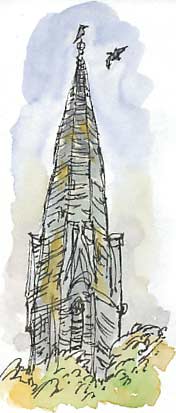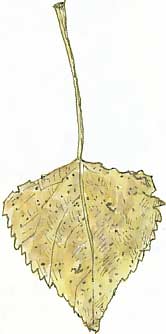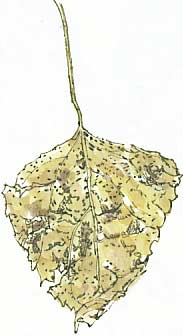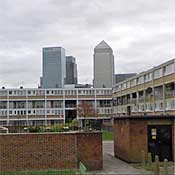 Poplar
Poplar Poplar
PoplarWild West Yorkshire, Thursday 28 October 2010
previous | this month | next
JACKDAWS were using the spire of the Methodist Church on Horbury High Street as a vantage point yesterday, followed by magpies when I passed later. The building is fenced off at the moment. The Victorian builders put all their effort into the magnificent frontage complete with gargoyles and, on the tympanum supported by granite pillars of the entrance, an elaborate carving of Christ preaching. Unfortunately the bits that didn't show from the High Street - such as the place where the roofs join - weren't completed with such care and the building is now under threat of demolition to make way for a car park for the congregation while services will be transferred to the former Primitive Methodist Ebeneezer Hall behind. A sign on the safety fence around the church proclaims, in large capitals 'OPEN FOR GOD'S BUSINESS AS USUAL' and an arrow points round the back.
 This little scene is one solution to not having the time I'd like to go out and draw on location at present; I photographed it as I walked to the bookshop to meet Barbara from work then drew it from the LED screen of my little camera later.
This little scene is one solution to not having the time I'd like to go out and draw on location at present; I photographed it as I walked to the bookshop to meet Barbara from work then drew it from the LED screen of my little camera later.
Other than that, we're back with the leaves again and leaf of the day today is poplar. It appears to be one of the widely planted varieties of black poplar, Populus nigra. Silver birch looks very similar at a glance but poplar has a longer stem. The teeth along the edge of the leaf of the silver birch are doubly serrate or doubly dentate; that means the individual smaller teeth are arranged in waves along the edge of the leaf so that in effect you've got little teeth set along the edges of bigger teeth.

 As you can see form my drawing, the poplar leaf is just plain dentate, or more accurately serrate, a botanical term meaning that it has forward-pointing teeth, like a saw. While a silver birch leaf is wedge-shaped the poplar is rhombic or lozenge-shaped.
As you can see form my drawing, the poplar leaf is just plain dentate, or more accurately serrate, a botanical term meaning that it has forward-pointing teeth, like a saw. While a silver birch leaf is wedge-shaped the poplar is rhombic or lozenge-shaped.
I'm learning an awful lot about leaves thanks to these evening visiting times!
In 1976 when I worked on the film Watership Down in London after I'd camped out in various temporarily spare rooms at my painter friend James Horton's place in a shared town house close to the zoo, I had an invitation to stay with my cousins, Janet and John Dredge, at Cordelia Street, Poplar. That was my only experience of living for a few months in a wholly urban environment. Walking to join the densely packed tube train from Mile End the view was mainly tarmac, concrete and brick, broken by only a few squares of grass and a narrow almost hidden canal. The visual highlight was  when I'd almost arrived at the station; there was a cinema that specialised in showing 'Bollywood' films and each week there would be a huge poster of the latest film filling most of the frontage of the building. I guess that in those days it was hand-painted. I remember one film must have been a kind of soap-cum-disaster movie featuring the handsome but hassled Indian hero gazing into the middle distance and his long-suffering but attractively demure female love interest in a supporting role with a whole host of disasters in the background for them to strive through on the widescreen including a spectacular rail crash (we're talking about autumn 1976 for the Mile End screening if there any Bollywood film buffs out there who may be able to tell me what the film was. Wonder if it's on DVD now? They don't make them like any more, do they?)
when I'd almost arrived at the station; there was a cinema that specialised in showing 'Bollywood' films and each week there would be a huge poster of the latest film filling most of the frontage of the building. I guess that in those days it was hand-painted. I remember one film must have been a kind of soap-cum-disaster movie featuring the handsome but hassled Indian hero gazing into the middle distance and his long-suffering but attractively demure female love interest in a supporting role with a whole host of disasters in the background for them to strive through on the widescreen including a spectacular rail crash (we're talking about autumn 1976 for the Mile End screening if there any Bollywood film buffs out there who may be able to tell me what the film was. Wonder if it's on DVD now? They don't make them like any more, do they?)
One Sunday morning I walked around the East End to get my bearings. The docks were largely derelict, what a contrast with today when the towers of Canary Wharf rise to the south of the flat where I stayed (right, image © Google Street).
Richard Bell, illustrator
previous | this month | Wild West Yorkshire home page | next